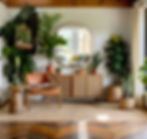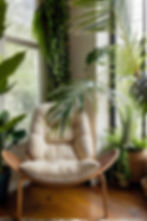A Guide to Biophilic Interior Design | 11 Key Design Elements
- Lydia Flynn
- Jul 30, 2024
- 7 min read
Updated: Feb 19

Table of Contents:
In a world ruled by technology, architecture, and artificial environments, we often find ourselves spending the majority of our time indoors. This can create a disconnection from the outside world, leading many of us to a desire to create a living space that brings us back in sync with nature.
One interior design style with a focus on getting closer to the outdoors is biophilic interior design. Embracing biophilic interior design is not just about aesthetics; it's about creating environments that promote harmony between ourselves and nature - a bond that can have several benefits for our well-being.
In this guide to styling a biophilic interior, we will explore 11 design elements that can help create a biophilic design, elevating your living space and bringing you closer to Mother Nature.
What is Biophilic Interior Design?
The word "biophilic" comes from "biophilia". The word combines the Greek "bio" (life) and "philia" (love). Today, "biophilic" describes designs that include natural elements to improve well-being and sustainability.
Growing evidence shows that spending time in nature can provide benefits in several areas such as improved sleep and mental health. This shows the power nature has to improve our well-being.
Biophilic interior design aims to create a living space that complements nature in various ways. This can include incorporating indoor plants, using eco-friendly systems and designs, and maximising natural light and fresh air.
However you choose to implement a biophilic interior design, ensure it feels authentic to you and your preferences. Explore our tips and suggestions below and pick and choose what feels right for you and your home.
Related Articles:
11 Design Elements for Biophilic Interior Design
1: Allow in Fresh Air

Maximising the amount of fresh air that enters your home is a great way to elevate your biophilic design.
Make a habit of opening your windows daily, even in winter. Just ten minutes a day can help remove stale air and bring a sense of freshness into your home.
2: Maximise Natural Light

The right lighting can completely transform any space. When it comes to biophilic spaces, natural light is crucial for creating a bright and lively environment, both in terms of aesthetics and atmosphere.
Features such as skylights and large windows can flood the space with natural brightness, bringing the outdoors inside.
To optimise natural light, choose sheer curtains over opaque ones, keep your windows clean, and remove any obstructions from natural light sources. Avoid placing bulky items on windowsills or furniture too close to the edges of windows, as this can restrict the amount of natural light that enters the space.
3: Include Natural Shapes

Furniture and decor with natural shapes are pleasing to the eye and help create a seamless and calming aesthetic. This is especially well-suited for the natural atmosphere found in biophilic spaces.
Consider curved armchairs, coffee tables or vases, along with decor and furniture with organic flowing lines that represent nature's imperfections, such as asymmetrical mirrors, raw wood shelving, or raw crystal lamps.
4: Choose Calming Colours

Colour is another make-or-break aspect of any interior design and biophilic spaces are no exception. While there are no hard-and-fast rules for colours, there are some staple options which are sure to create a natural and bright atmosphere.
Consider how you can bring colour into the space using natural materials, such as brown from natural wood, grey from stone, green from indoor plants and cream and white from natural cotton or linen.
In general, opt for muted tones for most of your interior design to create a calming, uncomplicated aesthetic. Consider, sage green, rust red, sandy beige, and off-white.
Related: Choosing Room Colour Based On Natural Light | A Guide for North, South, West & East-Facing Rooms
5: Nature-Focused Furniture

The main thing to remember when it comes to furniture for biophilic spaces is the materials they're made of. Opt for eco-friendly, ethically sourced and natural materials and fabrics when possible to create an authentic and earthy home environment.
Consider rattan bedframes or shelving, reclaimed wood or marble tabletops and natural fibres for upholstery and soft furnishings such as linen, bamboo or wool.
Furthermore, consider furniture with aesthetics that mimic nature's organic qualities like deep green rugs or blankets that resemble moss, or a wicker cocoon chair reminiscent of a cosy bird's nest. Better yet, go for pieces plucked straight from nature in their original form, such as a tree-stump coffee table or a driftwood lamp.
6: Incorporate Houseplants

Bringing nature indoors is one of the best ways to approach biophilic spaces. The presence of live greenery is a surefire way to create a rejuvenating, grounding and positive aesthetic and atmosphere.
Include a diverse collection of houseplants, filling blank spaces with greenery so each room feels like an indoor jungle. Choose from tropical plants such as monstera plants, palm plants or prayer plants, forest-dwelling plants such as ferns, and indoor flowering plants such as orchids, peace lilies or African violets. Consider hanging trailing plants to bring attention upwards and fill space from ceiling to floor.
Go a step further than simple potted plants and consider creating a plant wall using wall-mounted planters or floor-to-ceiling shelves. You could even select preserved moss art or terrariums to add interest and diversity.
7: Focus on Natural Materials

Pay close attention to the materials you select for architecture, furniture, soft furnishings, and decor. Wherever possible, select natural materials over synthetical ones. This will infuse your space with authenticity and create a grounding and calming atmosphere.
Incorporate natural materials like sustainably sourced wood, stone, bamboo, and terracotta to enhance biophilic architecture. These elements offer warmth, durability, and an organic aesthetic.
Likewise with furniture, choose reclaimed wood, rattan, wicker, stone or clay for frames and linen, cotton, bamboo or wool for upholstery.
8: Incorporate Water Features

Image Credit: KraftStories | Buy on Etsy
Water is one of the most soothing elements, and incorporating water features into your biophilic interior design can help create a relaxing ambience.
Water fountains are a great option as they provide not only aesthetic appeal but also a soothing auditory experience. Additionally, aquariums can add a touch of wildlife to your space.
The bathroom is a room where water can take centre stage. You can make your bathtub a statement piece by positioning it as the focal point of the room, or explore shower features such as waterfall showerheads to enhance the water-centric design.
9: Biophilic-Friendly Decor

Biophilic decoration is often simple yet not always minimalistic. Feel free to decorate in an eclectic style if that's your preference. Alternatively, if you want to create a serene atmosphere, consider focusing on blank space and neutral colours for a less-is-more approach.
Prioritise natural decor as the main focus such as houseplants and natural materials as we have already mentioned. Choose handmade decorations such as clay pots, unique artwork, or textile decor like macrame or fabric wall hangings.
To maintain a natural theme in your decor, select artwork or accessories that feature botanical or animal elements. This could include wildlife photography, organic candles, or botanical wallpaper.
10: Outdoor-Focused Layouts

The way you arrange your furniture and decor has a significant impact on the atmosphere. In biophilic interior design, the focus is on creating a space that embraces nature. Depending on the space you're working with, there are various ways to achieve this.
If you have a garden, terrace, or balcony, consider arranging most of your furniture to face the outside doors, allowing for an appreciation of the view.
Additionally, think about establishing a seamless transition to the outdoors by clearing any obstructions to your garden doors. You can also add inviting outdoor seating to your garden or balcony, or, if possible, incorporate features like conservatories or covered patios so you can enjoy the outdoors in any weather.
11: Be Environmentally-Friendly

Including eco-conscious elements in your biophilic interior design encompasses all of the points we've talked about so far - natural materials, nature-focused decoration, and a focus on bringing as much of the outdoors indoors as possible.
Also, be conscientious about what you buy for your biophilic home and conduct some research on the background of the companies you choose to buy from, including where they get their materials and how they treat their workers. Striving to create an authentic and ethical space will undoubtedly infuse positive vibes into your home.
You can start small by choosing natural, recycled, or ethically-made materials, or by opting for energy-saving lightbulbs. Alternatively, you can go the extra mile by incorporating features that maximize the sustainability of your home. If you have the budget, consider having solar panels installed on your roof to save energy, setting up a composting system to reduce waste, or choosing eco-friendly appliances.
Related Articles:
Embracing biophilic interior design is about more than just how your home looks but about how it makes you feel. By incorporating elements such as natural light, fresh air, calming colours, nature-focused furniture, and houseplants, you can create a home that not only looks beautiful but also contributes to your overall well-being.
Disclaimer: Your invaluable support through affiliate links allows us to sustain our mission of continuously inspiring and guiding you on your enriching home decor journey. It aids us in providing valuable insights, recommendations, and resources, ensuring that we can consistently offer quality content and advice to elevate your home's aesthetic and comfort.


